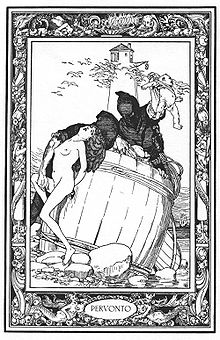Peruonto

Peruonto (also Pervonto ) is a fairy tale ( AaTh 675). It is in Giambattista Basile 's Pentameron collection as the third story of the first day (I, 3).
content
The idiot Peruonto is thanked by three fairy sons, whom he provides shade, that what he wishes will come true. As he rides home to his mother on a bundle of brushwood, the otherwise sad king's daughter Vastolla laughs at the sight. He then curses her to “get pregnant right away from this rod”. The king is offended when he notices the pregnancy and lets his council meet. They decide to have a feast for the rich, then one for poor citizens, the twin sons are seven years old and immediately seek Peruonto's proximity, which tells him. Vastolla, the children and him are thrown into the sea in a barrel. He turns it into a ship and finally into a castle. The king finds her there and is reconciled.
Remarks
The fairy tale is already in Straparola as III, 1 Pietro pazzo . Peruonto etymologically indicates 'per-unctus', i.e. H. 'anointed', in an ironic allusion to its origins. The king is annoyed that "the bean in this Epiphany cake, the main prize of the welfare raffle, fell on these ugly village idiots". On the sad king's daughter cf. the framework of the Pentameron and III, 5 the dung beetle, the mouse and the cricket , to the list with the festival I, 6 the ash cat . With regard to the fairy boys, here a blind motif, Rudolf Schenda compares Dan 3.15 EU and Mt 17.1 EU . He mentions Lu loccu di li passuli e ficu and La favola del falchetto in Pitrès' Sicilian and Tuscan fairy tale collections for oral dissemination in Italy . The first German translation was in von der Hagens' Stories and Fairy Tales from 1825, based on an abridged Italian version, then completely in Liebrecht , without various sexual metaphors from the baroque original. Christoph Martin Wieland wrote a retelling in verse under the title Pervonte . According to Walter Scherf , the entire narrative type AaTh 675 was called the Pervonto fairy tale for a long time . See Grimm's The Golden Goose , Hans Dumm .
literature
- Giambattista Basile: The fairy tale of fairy tales. The pentameron. Edited by Rudolf Schenda. CH Beck, Munich 2000, ISBN 3-406-46764-4 , pp. 42–49, 519–520, 576–578 (based on the Neapolitan text of 1634/36, completely and newly translated).
Web links
- Peruonto in modern Italian
- www.alaaddin.it: another version in modern Italian
- Gutenberg-DE: Pervonto in German translation (presumably after Felix Liebrecht)
- Peruonto in verse by Laura J. Bobrow
- surlalunefairytales.com: Illustration by George Cruikshank
- Staatliche Kunstsammlungen Dresden: Pictures by Josef Hegenbarth from Peruonto : [1] ; [2] ; [3]
Individual evidence
- ^ Giambattista Basile: The fairy tale of fairy tales. The pentameron. Edited by Rudolf Schenda. CH Beck, Munich 2000, ISBN 3-406-46764-4 , p. 576 (based on the Neapolitan text from 1634/36, completely and newly translated).
- ^ Giambattista Basile: The fairy tale of fairy tales. The pentameron. Edited by Rudolf Schenda. CH Beck, Munich 2000, ISBN 3-406-46764-4 , p. 46 (based on the Neapolitan text of 1634/36, completely and newly translated).
- ^ Giambattista Basile: The fairy tale of fairy tales. The pentameron. Edited by Rudolf Schenda. CH Beck, Munich 2000, ISBN 3-406-46764-4 , pp. 519-520, 576-578 (based on the Neapolitan text of 1634/36, completely and newly translated).
- ↑ Walter Scherf: The fairy tale dictionary. Volume 2. CH Beck, Munich 1995, ISBN 3-406-39911-8 , pp. 935-936.